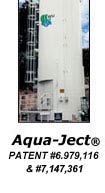|
|
 |
 |
WSI EXCLUSIVE!
NEW TECHNOLOGY! |
 |
Improving Treated Wastewater Quality for Irrigation
By Jerry B. Rivers • Owner - Growers Testing Services • Visalia, California
|
|
In California, some 200 waste treatment facilities produce approximately 4.0 million acre-feet of treated wastewater
annually (CA State Water Resources Control Board survey). There is widespread and increasing interest in reusing treated wastewater
for beneficial and environmentally safe purposes. Currently, only about 10% (400,000 acre-feet) of this resource is directly reused.
Of the 10% reused, 48% (193,500 acre-feet) is used for agricultural irrigation, and another 20% (78,500 acre-feet) for landscape
irrigation and impoundment.
Clearly, agricultural and turf/landscape irrigation represent the most important area in which this valuable resource is used.
Treated wastewater represents a stable and reliable source of irrigation water and often provides significant levels of required
plant nutrients, such as potassium and iron. At the same time, potential users frequently have the perception that reclaimed water
may not be suitable as irrigation water.
Water Quality Defined: In most states, the quality of treated wastewater is typically defined in terms or regulations set forth in Administrative Code.
These regulations define wastewater treatment levels and allowed uses for the reclaimed water produced. The intent of the regulations is to protect public
health. While laws exist to protect public health, they do not address the water chemistry considerations that determine the suitability of treated
wastewater for agricultural and landscape irrigation. When considered for use as irrigation water, the actual quality of treated wastewater ranges
from totally unsuitable to ideally suitable, with most sources falling somewhere in between these extremes.
Treated wastewater from each waste treatment facility has its own chemical makeup containing, in addition to water, dissolved minerals and gases
in varying amounts. The final composition is determined by the domestic water source(s), by the domestic and industrial water uses and, to some
extent, by the methods used to produce the treated wastewater. These chemical constituents and their relationship to each other and to the
chemistry of the soils to be irrigated determine the suitability of the water for agricultural and landscape irrigation. These interactions
can be predicted from a complete laboratory analysis of the water and of the soil to be irrigated with the water.
When treated wastewater is being evaluated for irrigation use, the most serious potential problem is the presence of ions directly toxic to
plant life, such as high levels of sodium, chloride and boron. Wastewater of this quality should not be considered for irrigation use.
Fortunately, only a fraction of the treated wastewater available for reuse falls in this category.
When treated wastewater is used for irrigation, the problems that can occur are usually caused by poor chemical balance and the resulting negative
impacts that accumulate over time. Soil will always take on the characteristics of the water with which it is irrigated. Domestic and industrial
water use always increases the sodium level. In the absence of adequate calcium, even low levels of sodium will destroy soil structure and reduce
water infiltration into the soil over time. Reduced water infiltration inhibits leaching of the soil profile, further concentrating sodium and
other toxic ions.
High alkalinity in treated wastewater causes precipitation and buildup of calcium carbonate in the soil (called excess or free lime). This process
reduces available calcium while raising soil pH. High soil pH causes a dramatic reduction in nutrient availability. Reduction of available calcium
leads to loss of soil structure and to reduced water infiltration, which in turn reduces the normal leaching process by which "salts" are moved
down through the soil profile. Treated wastewater dominated by magnesium (Ca/Mg ratio less than one) can cause reduced water infiltration,
especially in the presence of sodium.
Water Quality Optimized: Water amendment equipment and processes are available that can optimize the quality of treated wastewater for
irrigation use, primarily by increasing the calcium and lowering the alkalinity. High sodium levels and calcium/magnesium imbalances are water
chemistry problems that directly reduce water infiltration. Amending such water with dissolved gypsum will increase the calcium level, which
can reduce the negative effects of sodium and provide proper calcium/magnesium balance.
Neutralizing most of the bicarbonate ion with acid can eliminate the negative effects on the soil caused by high alkalinity. Without high
alkalinity in the water, soil pH can be easily maintained at a desirable level, nutrient availability is optimized, available calcium levels
remain high, and soil structure is maintained and improved.
Water Amendment Benefits: Using water amendment equipment and processes to optimize the quality of treated wastewater encourages
its reuse for agricultural and landscape irrigation. This puts the treated wastewater to beneficial use, utilizing the nutrients present
in the wastewater, replacing surface and well water normally used for irrigation, and distributing the wastewater over the widest possible
area while reducing the need to hold it at the treatment facility.
Water chemistry problems can impose severe limitations on the use of treated wastewater for irrigation. Amendment processes can optimize water
quality for irrigation, minimizing or eliminating its negative impacts on plants and soils. Through water amendment, treated wastewater can
become a more suitable and valuable water source for agricultural and turf irrigation.
|
|
|





















